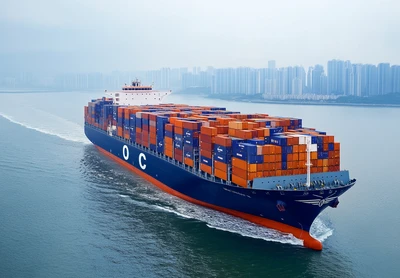
Since the end of the pandemic, sea freight rates have not experienced significant fluctuations, maintaining a steady course. However, starting from May, these rates have seen a continual rise. With major shipping companies already announcing rate increases for July, we delve into the reasons behind this surge and how it affects global shipping dynamics.
1. Economic Downturn in 2023
In 2023, the global economy saw a downturn across various sectors. This economic slowdown impacted the shipping industry, with many companies experiencing a decline in performance. The reduced economic activity led to a decrease in demand for shipping services, causing a temporary stabilization in sea freight rates. However, as economic activities pick up, the demand for shipping has surged again, contributing to the rising freight costs.
2. Red Sea Crisis and Its Impact
The Red Sea Crisis has forced a significant portion of ships bound for Europe to reroute via the Cape of Good Hope in Africa. This diversion extends the journey by 8,000 to 10,000 kilometers, adding approximately two weeks to the travel time. The prolonged voyages have resulted in a global shipping congestion, as ships take longer to return to their points of origin. This has led to a shortage of vessels and containers at Chinese ports, exacerbating the difficulty of securing bookings and pushing freight rates higher.

The tension in the Red Sea is expected to persist, with its ripple effects continuing to impact global industries and markets. This ongoing crisis contributes to the relentless rise in sea freight rates, significantly affecting businesses worldwide.
3. Inventory Replenishment Cycle
Following the pandemic, many international factories had halted operations, leading to an unprecedented demand for Chinese exports. Consequently, numerous clients stocked up on large inventories. Throughout 2023, businesses primarily focused on depleting these stockpiles, resulting in a relatively stable foreign trade environment. As we enter 2024, the need to replenish inventories has become urgent, especially with the upcoming U.S. elections increasing demand for specific products such as solar PVC panels, electronic goods, Yiwu commodities, and new energy vehicles.

4. Pre-Tariff Surge in Shipping Demand
On May 22, the U.S. Trade Representative's office announced new tariffs on Chinese imports, effective August 1. These tariffs will significantly impact products like electric vehicles, computer chips, and medical supplies. Here are some of the key adjustments:
· Steel and Aluminum: From 7.5% to 25% this year.
· Semiconductors: From 25% to 50% before 2025.
· Electric Vehicles: From 25% to 100% this year.
· Lithium-ion EV Batteries and Parts: From 7.5% to 25% in 2024.
· Solar Cells: From 25% to 50% this year.
· Ship-to-Shore Cranes: New 25% tariff this year.
· Medical Products: Tariffs on PPE and rubber gloves rising to 25%, syringes and needles to 50% in 2024.

In anticipation of these tariffs, many businesses, particularly in the electric vehicle sector, are rushing to book as much shipping space as possible before the new rates take effect. This surge in demand has led to a scarcity of available shipping slots, naturally driving prices up.

5. Conversion of Currency to Assets
Globally, the devaluation of paper currency is an unstoppable trend, with inflation rising rapidly. Regardless of whether the Federal Reserve cuts interest rates, the trust in the dollar is likely to be affected. This has increased the demand for converting paper money into tangible assets, further fueling the demand for shipping services and pushing freight rates higher.

Experts suggest that sea freight rates might see a decline in August, although the extent of this decrease remains uncertain. However, based on our experience, the typical peak season occurs in the latter half of the year. Even if rates drop in August, they are likely to rise again in October due to increased demand from Black Friday, Christmas, the U.S. presidential election, and the New Year.
For Urgent Shipments:
If your goods are urgently needed, we recommend arranging shipments as soon as they are ready. Delaying shipment may result in the inability to secure space.
For Non-Urgent Shipments:
If your goods are not urgently needed, it might be wise to wait and observe the market. If August sees no significant drop in rates, it is still advisable not to delay further. Planning shipments in August or September can help avoid the higher rates expected in October.
For further assistance in planning your shipping strategies, contact us at CUC Freight. We are dedicated to helping our clients achieve seamless international transportation and mitigate the impacts of these rising sea freight rates.
 Exploring the Impact of Shipping Agent China to USAMarch 13, 2024In today's era of globalization, the freight forwarding industry plays a crucial role as a vital link in international trade. China and the United States, as the two largest economies globally, wi...view
Exploring the Impact of Shipping Agent China to USAMarch 13, 2024In today's era of globalization, the freight forwarding industry plays a crucial role as a vital link in international trade. China and the United States, as the two largest economies globally, wi...view Sod HS Codes, Let’s Talk Proper China ShippingMarch 24, 20251: When the Bollocks Hit the Container“Bloody hell, they’ve classed our hinges as ‘furniture parts’ again!” I yelled at the customs letter, which demanded £2,800 for “luxury goods storage” – ...view
Sod HS Codes, Let’s Talk Proper China ShippingMarch 24, 20251: When the Bollocks Hit the Container“Bloody hell, they’ve classed our hinges as ‘furniture parts’ again!” I yelled at the customs letter, which demanded £2,800 for “luxury goods storage” – ...view Door-to-Door Dominance: Slash China-US Air Freight Costs While Beating Delivery DeadlinesMarch 17, 2025Cut China-US air freight costs 18-35% while accelerating door-to-door delivery. Master cargo hacks, forwarder negotiations & hybrid logistics. Free tools: density calculator + customs checklist.view
Door-to-Door Dominance: Slash China-US Air Freight Costs While Beating Delivery DeadlinesMarch 17, 2025Cut China-US air freight costs 18-35% while accelerating door-to-door delivery. Master cargo hacks, forwarder negotiations & hybrid logistics. Free tools: density calculator + customs checklist.view Attention please! Shanghai Port is closed due to heavy fog | Shipping company issues delay noticeApril 22, 2024Affected by the humid and warm air flow, heavy fog occurred in the areas along the Yangtze River Estuary in Shanghai on April 15. The visibility in the waters of the Yangtze River Estuary was less tha...view
Attention please! Shanghai Port is closed due to heavy fog | Shipping company issues delay noticeApril 22, 2024Affected by the humid and warm air flow, heavy fog occurred in the areas along the Yangtze River Estuary in Shanghai on April 15. The visibility in the waters of the Yangtze River Estuary was less tha...view